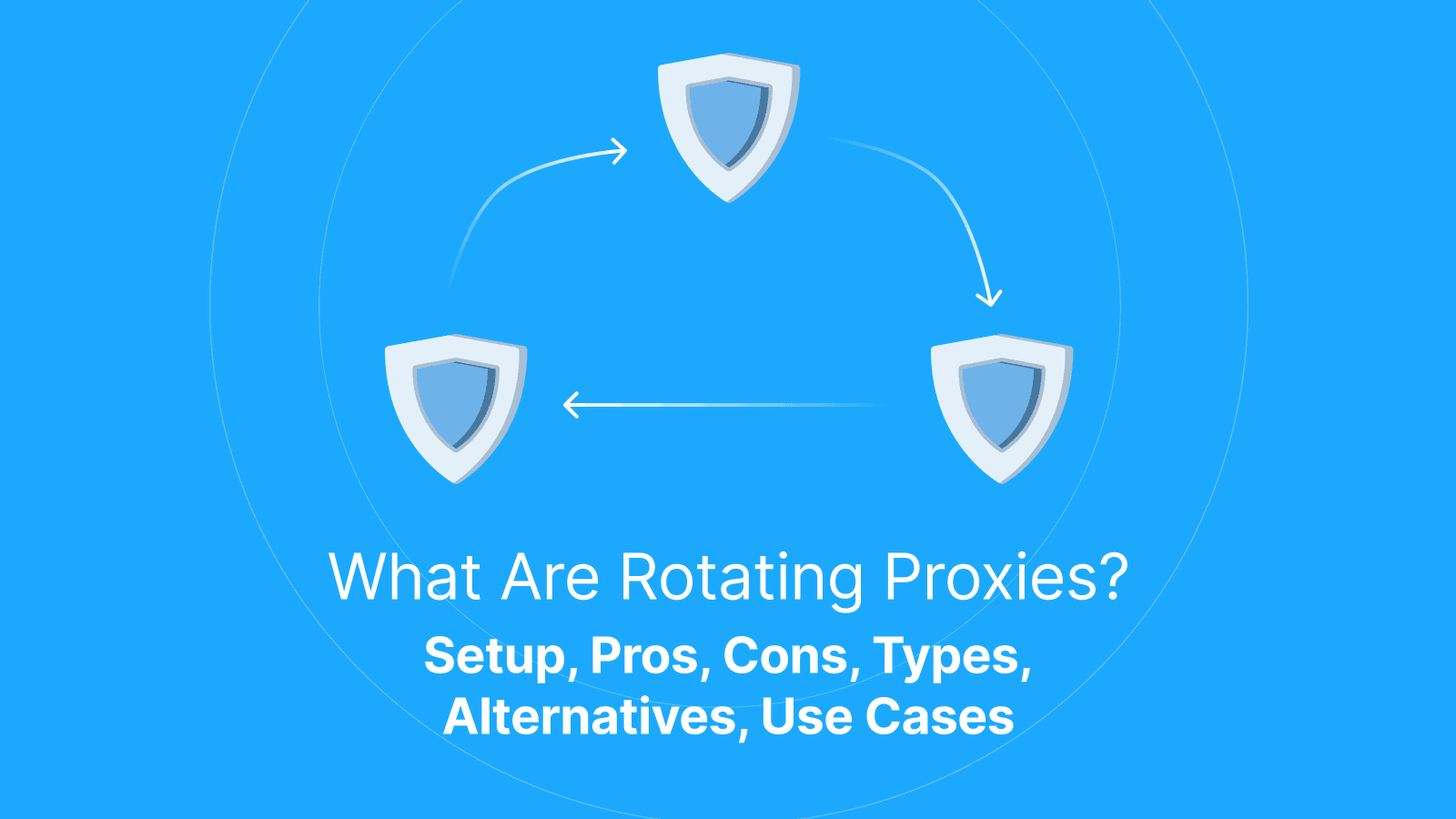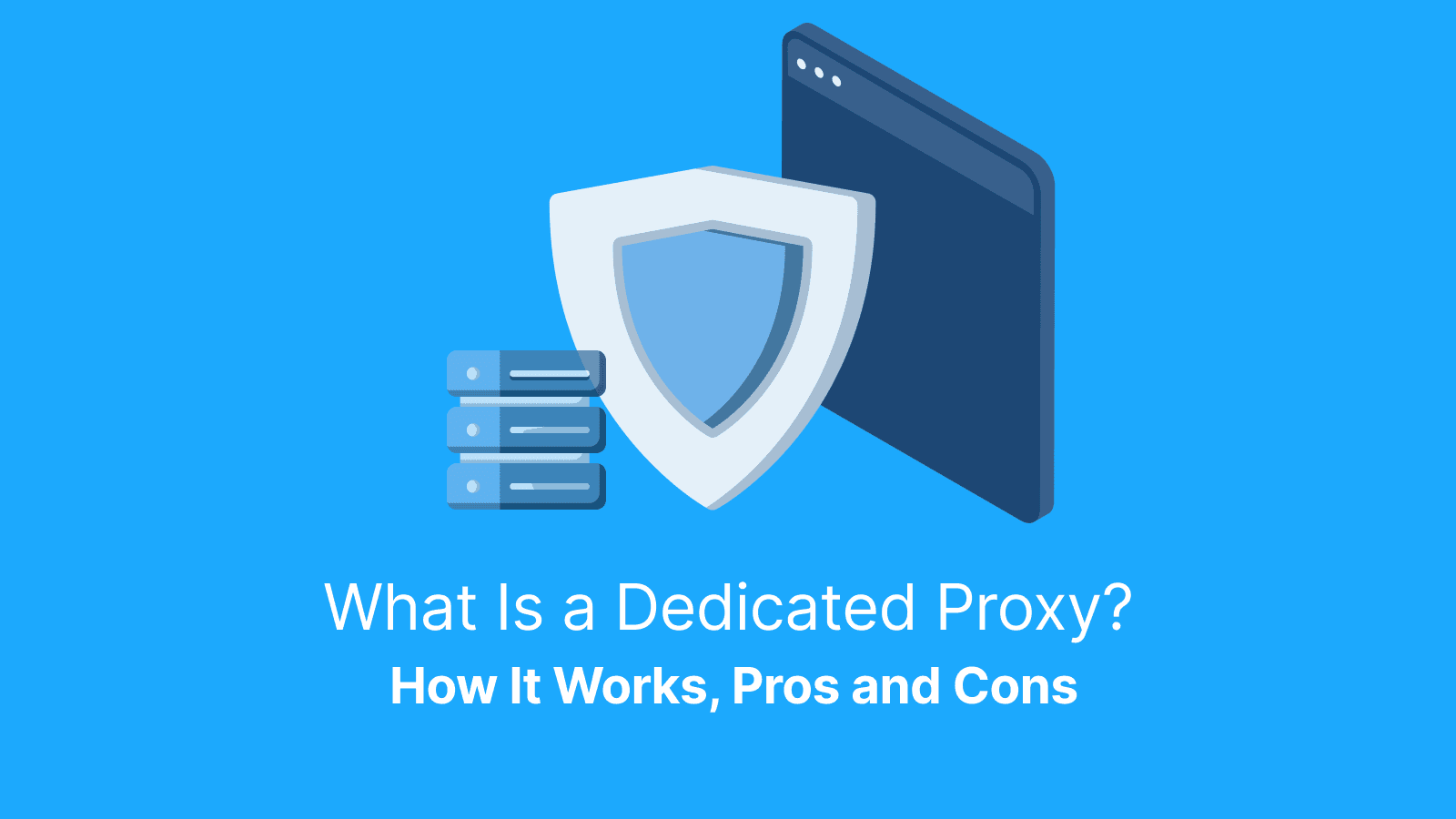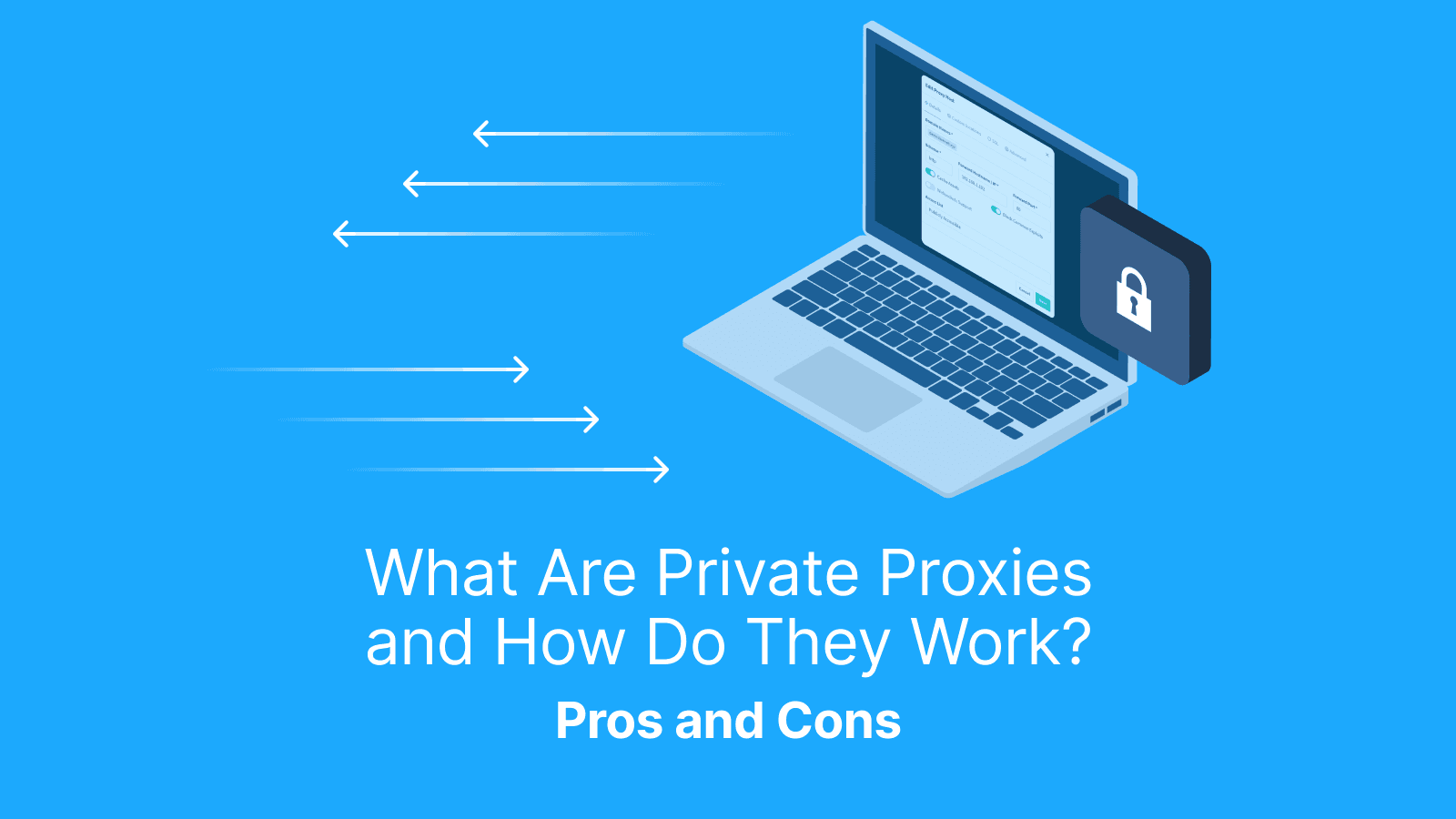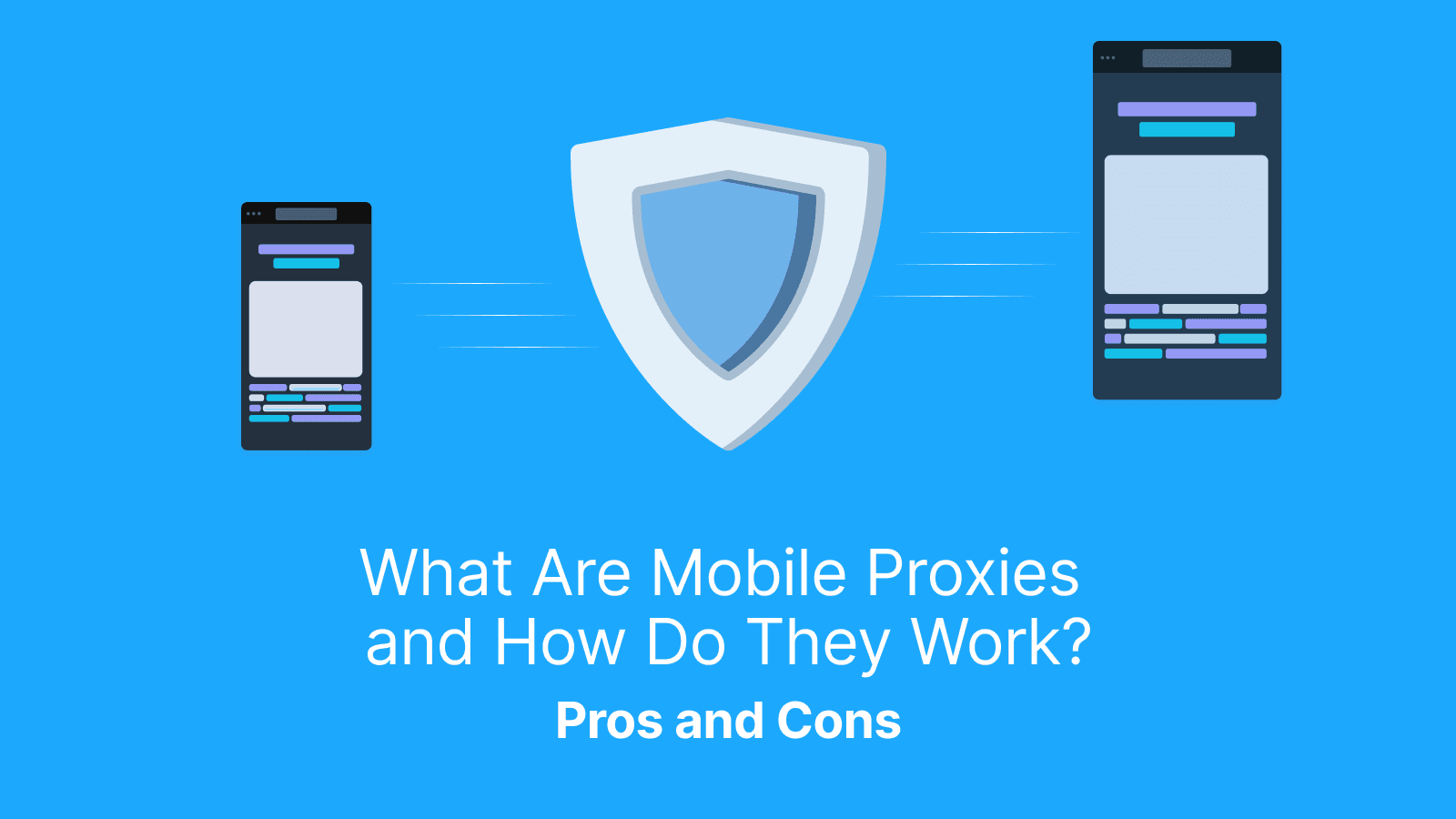Rotating proxies are proxy servers that automatically change your IP address at set intervals or per request in order to hide your actual IP. It helps users avoid rate limits, bypass geo-blocks, and navigate increasingly strict anti-bot systems.
In this guide, we’ll break down how rotating proxies work, quick setup steps, the main types (datacenter, residential, ISP, and mobile proxies), the pros and cons, and detection risks. You’ll also learn how to choose the right provider, metrics for measuring, alternatives, and troubleshooting tips.
What is a Rotating Proxy?
A rotating proxy is a type of forward proxy gateway that automatically switches the outgoing IP address while you keep connecting to the same endpoint or destination website. This automatic switch in your IP address may either occur with every request or after a set time.
Some of the terms related to the use of this proxy/system are: “rotating endpoint,” which means the access point, “pool,” which means the collection of available IPs, and “session ID,” which lets you hold a temporary identity. Unlike static or dedicated proxies that stick to one IP, the main advantage of a rotation proxy is that it makes it harder for sites to track your activity. Therefore, this helps you avoid throttling or soft bans.
Rotating Vs. Sticky Vs. Static
Rotating proxies change with every request for maximum variety, while sticky sessions hold the same IP for a set time (like 1–30 minutes) in order to keep carts or logins stable. However, static IPs stay fixed for allowlists or long API sessions. The general rule of thumb is that the more stateful the target, the longer the stickiness you’ll need.
How Do Rotating Proxies Work?
When you connect through a rotating proxy, your client first authenticates with the provider’s gateway. Then, selection logic such as random choice, least-used IP, or filters based on geography or ASN is used to assign an address. The request is then forwarded to the target site, which sends the response back through the same gateway.
Note that DNS resolution happens either locally or at the proxy (a key detail for geo-testing and leak checks). Also, IPs often rotate on a timer or when event triggers like HTTP 403, 429, or 5xx errors occur.
What are the Rotation Strategies?
Manage or control rotating proxies by either choosing per-request rotation for high-volume tasks or time-based switching every 60–300 seconds. Also, choose error-triggered swaps when a connection fails, or session-pinning (using a session parameter), and geo/ASN pinning, which helps to keep identity steady where needed.
Match your rotation cadence to the site’s strictness. Such strictness includes per-request for catalog scraping or 5–10 minute sticky sessions for login flows.
Further reading: Enhancing Proxy Workflows with IP Intelligence (ASN, Carrier, VPN/Proxy Detection) and Why Ad Verification Requires Precise IP Geolocation.
Setup and Quick Start
Get started with rotating proxies in three ways:
- Using a managed rotating gateway where one hostname handles everything
- Running client-side rotation over a proxy list
- Plugging into SDKs/connectors.
For whichever path you choose to start, run a quick 5-minute test by checking your egress IP and country. Also, open a strict site to spot 403/429 errors, tweak stickiness or headers, and note the time-to-first-byte. This quick test will let you know if the performance of the proxy is dialed in from the start.
CLI/CURL Sanity Check
One quick way to test rotating proxies is by pointing curl at your gateway. Authenticate and run 3–5 requests in a loop, and log the changing public IPs. Then, switch geographical location to confirm that the rotation works.
Python/Playwright Quick Start
In Playwright, pass proxies through environment variables or directly in your request arguments. Another thing is to layer in retry and backoff logic for failed calls, and maintain a session token if you need sticky behavior. Ensure that proxy authentication prompts are handled correctly when running in headless mode.
Which Types of Rotating Proxies Exist?
There are different types of rotation proxies. Each of these types has its unique characteristics, advantages, and use cases. They are:
- Rotating Datacenter Proxies: This type of rotating proxy is ideal when speed and cost matter, but it offers lower trust and is often billed per port or thread. They use IPs from hosting or cloud providers, not real residential devices, which makes them faster but easier to detect.
- Rotating ISP/Static Residential Proxies: ISP proxies combine the stability of datacenter servers with real residential IP registration. They offer persistent sessions under consumer ISPs but are hosted in data use real IP, and are better for avoiding detections and blocks. Meanwhile, you’ll often pay more per GB, choose city or ASN targeting for precision, and work within typical sticky sessions that last only a few minutes.
- Rotating Mobile/4G/5G Proxies: Mobile proxies operate via carrier-grade NAT (CGNAT), meaning thousands of users share a single IP. This naturally blends automation traffic into legitimate mobile behavior, which gives mobile IPs the highest trust score.
What are the Pros and Cons of Rotating Proxies (Trade-offs That Matter)?
There are multiple benefits and some drawbacks rotating proxy users may experience.
Pros
- Improve Anonymity: Rotating proxies helps lower tracking and blocking as requests are routed through different locations.
- Better Access to Geo-Restricted Content: By switching between proxies, you may be able to access websites that limit content based on location or IP address.
- Loads Distribution: Requests are distributed across many IPs which reduces strain on any single server.
Cons
- Inconsistent Performance: Since IPs are changed often, users may experience inconsistent connection speed.
- Risk of Getting Blocked: Frequent IP changes may trigger anti-bot systems and subsequently result in a block.
- Cost Intensive: Compared to IPs from datacenters, quality rotating proxies cost more.
When Should You Choose Rotating Instead of Static?
Here are some use cases to consider when choosing a rotating proxy over a static proxy:
- Crawling at scale and checking prices or availability across regions
- Running SERP or ad verification in multiple cities
- Stress-testing uptime and user experience.
However, stick with static or dedicated IPs for steady account management, allowlisted APIs, long checkout flows, or compliance-heavy workflows. Ensure that you validate your choice with a one-week A/B pilot, measuring the success rate, error types, and cost per successful page.
Use-Case Snapshots
Some of the most popular use cases for a rotating proxy are:
- Price Intelligence Across 20 Countries: A retail analytics team may run price checks across 20 markets without triggering blocks, as rotating proxies swap IP addresses per request. This rotation ensures a wider coverage of competitor data and reduces downtime from rate limits.
- City-level SERP Tracking: Agencies that track search results by city use rotating residential proxies to appear local in each region. This guarantees consistent snapshots of rankings without skew from location filters or IP bans.
- Advert Verification for Geo-targeted Creatives: Marketers verifying ads in different regions rely on rotating proxies to confirm correct delivery. By changing IPs, they see how creatives display across multiple geos without being flagged as suspicious traffic.
- Marketplace Inventory Checks with Rotation on 429/403 Events: E-commerce teams who monitor stock across marketplaces use rotating proxies. These proxies automatically switch IP addresses when a 429 or 403 error occurs. This allows steady data collection even under strict anti-scraping defenses.
How Do Blocks Actually Happen?
Modern anti-bot systems flag suspicious IPs by combining reputation feeds, ASN, and subnet patterns to distinguish between datacenter, residential, and mobile traffic. They also combine TLS/JA3 and browser fingerprints, odd request timing, reused cookies or devices, geo-velocity jumps, and even canary endpoints. This means rotating proxies helps break simple correlations but won’t hide automation if your headers, behavior, or parsing speed look unnatural or suspicious.
Minimizing Friction (Ethically)
The best way to minimize friction with rotating proxies is to play fair by respecting robots.txt and site terms. Also, space out your requests with throttling and random intervals, mix up headers and navigation patterns.
In addition, you may follow cache and crawl-delay hints, and use sticky sessions only when login flows demand it. This makes your work stay reliable, compliant, and focused on clean data quality instead of dodging detection.
What Really Matters when Selecting a Proxy Provider in 2025?
When choosing a rotating proxy provider, look beyond marketing claims and check for essentials like pool size and freshness. Also look out for flexible rotation controls, depth of geo and ASN coverage, and support for both HTTP(S) and SOCKS5 protocols.
Also, prioritise providers that offer success/error telemetry, clear pricing with transparent GB tiers and overage rules, and fair replacement policies. Also, consider providers that offer intuitive dashboards or APIs, strong security, logging practices, and fast and offer reliable support.
Why Choose Live Proxies as a Rotating Proxy Provider
A provider like Live Proxies serves as a benchmark example of access-controlled platforms that combine residential, and mobile pools with city/ASN targeting. Live Proxies offer a large and diverse IP pool across 55+ countries which gives good geographic spread.
There are also multiple rotating proxy types and a sticky session that is up to 60 minutes. The IPs are ethically sourced, with custom options for B2B brands. IPs are privately allocated to users and the dashboard is user-friendly.
Red Flags and Buyer Traps
When choosing a provider, watch out for recycled public IPs, shady “unlimited” offers that throttle, and unclear sourcing. Do not engage a provider if they have no replacement guarantees, clunky dashboards, or miss compliance documents. Always run a small paid test on real targets before locking into a long-term deal.
Geo and ASN Targeting: Why Location Fidelity Matters
The location of your proxy, down to the city and even the network (ASN), directly shapes the prices, search results, and app flows you see. As a result, stick to city-level targeting and use the right carrier or mobile ASN to help mimic real users.
Additionally, excessive geo-hops in a single session may trigger fraud detection systems. This is why it’s smarter to keep your geo steady during one session and only rotate between sessions.
Do IPv6 Rotating Proxies Help?
While IPv6 offers a huge IP pool, many targets and CDNs still deprioritize or lack IPv6 parity. For web scraping and SEO tasks, IPv4 remains the dominant and more compatible option. Endeavour to run small pilots with both IPv4 and IPv6 and compare success rates and error logs. Then, scale with the proxy that offers you more benefits.
Headless Browsers and Anti-detect: Getting Rotations Right
When you're working with rotating proxies, pair them with realistic browser fingerprints through anti-detect or multi-profile tools. Additionally, maintain consistent user-agents and design smooth navigation flows.
Utilize sticky sessions for logins or shopping carts, and employ per-request rotation for public pages. However, always test carefully, as HTTP/2 multiplexing and service workers may sometimes interfere with proxy behavior.
Read more: What Is a Headless Browser? Definition, Uses & Examples and How to Use BrowserScan to Detect Browser Fingerprints.
Metrics to Measure
To get real value from rotating proxies, keep tabs on success rate, CAPTCHA frequency, average time-to-first-byte, retries per success, error mix (403/429/5xx), and cost per 1,000 successful pages. Also, look out for how complete your data is (duplication or miss rate), then use a simple scorecard to compare providers, regions, and rotation speeds against the same target list.
What Alternatives Hybrids Should You Consider?
If you seek other proxy alternatives other than rotating proxies, you may consider static or dedicated proxies for stable sessions with allowlists. Alternatively, you may use ISP or static residential options for higher pass rates and fewer IP changes.
API data providers are another alternative to consider if you just need specific datasets without scraping. In addition, you may use VPNs for device-wide routing, although they’re not great for high-concurrency tasks. It is a wide practice by many teams to use hybrids like datacenter rotation for scale, combined with residential stickiness to handle harder endpoints.
What are the Quickest Ways to Troubleshoot and Fix Rotating Proxy Issues?
The quickest way to fix a proxy-related breakdown problem is to follow the operator’s flow. This means that first, you check the logs, match the symptom to a likely cause, and try the simplest knob first.
A 407 error means that proxy authentication is required ( bad/missing proxy credentials), while a 429 error calls for slowing requests or speeding up rotations. On the other hand, a 403 error often clears with new headers, user agents, or a fresh ASN/geo, and a 5xx error suggests that you back off and retry again.
Timeouts usually need fewer parallel threads or closer locations. For this reason, always make one small change at a time and measure the before and after results.
What are the Common Rotating Proxy Errors and How to Fix Them?
Here are common errors that are associated with rotating proxies and how to troubleshoot them.
- Connection Timeouts: Proxy servers may take too long to respond. An easy fix is to increase timeout settings, implement retry logic or switch to a faster proxy provider like Live Proxies.
- Authentic Errors: This happens due to incorrect credentials. To fix, double check proxy authentication details and ensure codes send the credentials in the right format.
- Proxy Pool Exhaustion: Running out of available proxies may result in increased detection risks. Increase the size of the proxy pool, and regularly refresh your proxy list from the provider.
How Are Rotating Proxies Priced?
Rotating proxies are usually priced per gigabyte for residential or mobile networks and per IP or port for datacenter or ISP options. It also comes with extra costs often tied to location targeting, replacement fees, bandwidth limits, and features like city-level precision or sticky sessions. In other words, it is best to calculate the true cost per successful page load and only commit to longer contracts after testing the service in a short 1–2 week pilot.
Compliance, Privacy, and Data Handling
The use of proxies is legal in most cases, but how you use them matters. You may cross the line both ethically and legally when you scrap without permission, bypass security rules, or collect sensitive information. Therefore, it’s best to stick with least-privilege data collection, respect robots.txt, protect your login details, and only work with providers who are clear about their logging and data-retention practices. It is important to note that robots.txt is not a legal permission, so seek legal counsel when in doubt.
Conclusion
Rotating proxies are best seen as a reliable tool for large-scale, geo-diverse data collection and testing. Combine smart rotation with careful pacing, good fingerprint practices, performance tracking, and a trusted provider to achieve better results.
Try a few vendors like Live Proxies and two alternatives, compare results against costs, and stick with the simplest setup that delivers consistent outcomes.
FAQs
What is a rotating proxy in simple words?
A rotating proxy is a proxy type that changes your IP address each time traffic is routed through the proxy. This is like making phone calls with a different number each time so you don’t get flagged or blocked too quickly.
Are rotating residential proxies better than datacenters?
This really depends on what you need. Rotating residential proxies usually work better for strict sites that check IPs closely, while datacenter proxies are faster and cheaper for easier targets. To know which is “better” for you, run a small A/B test on your actual endpoints before making a decision.
What’s the difference between sticky and rotating sessions?
A sticky session keeps you on the same IP for a set time and is helpful for logins or checkouts. However, a rotating session switches your IP often, and it is much better for large-scale crawling. Choose a longer window if you need consistency, and shorter ones if you need scale without blocks.
Will rotating proxies stop CAPTCHAs?
Rotating proxies may cut down on seeing the same CAPTCHA over and over again. But they won’t stop them completely since your browsing behavior and fingerprints also matter. You may combine rotation with natural pacing, realistic navigation, and the right headless or browser settings to reduce friction.
Are 4G rotating proxies worth the premium?
4G rotating proxies are usually more expensive because they use real mobile networks. Investing in them is worth it when you need to test mobile-only apps, bypass tough filters, or access endpoints that only accept mobile traffic. It's ideal to save them for high-value projects where the return justifies the higher cost.
Is a VPN the same as a rotating proxy?
A VPN encrypts all your device’s traffic through one secure tunnel. So, it is great for personal privacy or streaming abroad. However, a rotating proxy only routes specific apps or browser sessions and switches IPs on every request. If you just want safer browsing anywhere, a VPN is good to go. But if you need many IPs at once for tasks like scraping or ad verification, go with rotating proxies.




